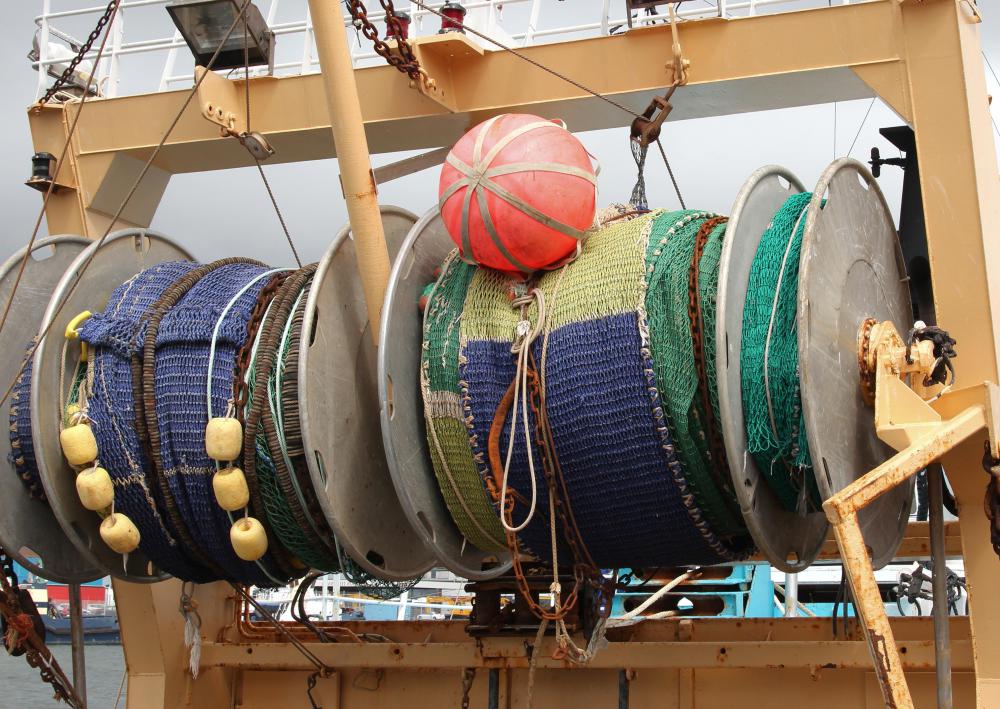At AllThingsNature, we're committed to delivering accurate, trustworthy information. Our expert-authored content is rigorously fact-checked and sourced from credible authorities. Discover how we uphold the highest standards in providing you with reliable knowledge.
What is a Saw Shark?
A saw shark is a member of the Pristiophoriformes order of sharks, which contains seven species that are known for elongated snouts edged with sharp teeth of alternating length. The saw shark has two long barbels connected to its snout that it uses for hunting and subduing the small fish, squid and crustaceans that it eats. A saw shark's appearance is dominated by the length of its rostral snout, often reaching 30 percent of the shark's body in size. The shark reaches average lengths of 3 feet (1 m), and are located in the oceans surrounding Japan, Australia, South Africa and the Caribbean.
Saw sharks are often confused with saw fish because they have a similar appearance. The two creatures differ in that a saw shark has gills on the side of the head, making it a true shark, and a saw fish has gills located on its underneath. Additionally, a saw fish does not have long barbels like a saw shark, and its teeth are all the same size instead of alternating in length like a saw shark's teeth.

Within the Pristiophoriformes order, there are seven types of saw sharks. The first species, Pliotrema, has six gill slits, and the other six species have only five gill slits. Pliotrema also differs from the other species of saw sharks in that its teeth have basal ledge ridges and posterior serration. This species of saw shark lives exclusively in the Indian Ocean.

There is no known danger to humans from saw shark attacks, and the sharks are believed to be numerous, with no danger of extinction. When caught by fisherman, the underbelly of the shark is cooked and eaten as a delicacy, especially in Australia. The rostral nose of the shark is often removed by fisherman and sold separately as an ornament. The saw shark usually is caught unintentionally in the nets intended for other types of fish.
When hunting, saw sharks swim along the bottom of the ocean, through the mud and sediment. It uses its barbels to locate small fish, crustaceans and squids that are hiding. The barbels contain chemical receptors and use pressure sensors to seek out prey. Once prey is located, the shark tosses its head violently side to side, impaling its prey using its serrated teeth and rostral snout.
The life expectancy of a saw shark is 10 to 15 years. The sharks are ovoviviparous, meaning they give birth to live young that develop as eggs inside of the uterus. As many as 22 babies can be born at one time, and they usually are born during the winter months.
Frequently Asked Questions
What is a saw shark and how does it differ from other sharks?
A saw shark is a distinct group of sharks known for their elongated, blade-like snouts edged with teeth, resembling a saw. Unlike other sharks, saw sharks use their snouts to detect and incapacitate prey by swinging it side to side. They are smaller and less aggressive than many shark species, with a size ranging from 1.4 to 1.5 meters in length.
Where can saw sharks be found in the world?
Saw sharks are primarily found in the waters of the western Pacific Ocean, around Japan, Australia, and South Africa. They inhabit continental shelves and slopes, preferring muddy or sandy bottoms where they can easily hunt for small fish and invertebrates. Their habitat ranges from shallow coastal regions to depths of up to 800 meters.
What do saw sharks eat and how do they hunt?
Saw sharks are carnivorous, feeding on small fish, crustaceans, and squid. They hunt by using their saw-like snout to detect prey through electroreception and then disable them with swift, side-to-side movements. This unique hunting method allows them to unearth buried prey and slash through schools of fish with precision.
How do saw sharks reproduce?
Saw sharks are ovoviviparous, meaning their eggs develop and hatch inside the female's body, and the young are born live. Females give birth to relatively small litters, usually between 6 to 12 pups. The gestation period can last several months, after which the fully developed young are born, ready to fend for themselves.
Are saw sharks considered dangerous to humans?
Saw sharks are not considered dangerous to humans. They are generally shy and avoid contact with people. Their small size and the nature of their diet, which consists of small marine organisms, make them of little threat. There have been no recorded incidents of saw sharks attacking humans.
What conservation status do saw sharks have?
Some species of saw sharks are listed as "Least Concern" by the International Union for Conservation of Nature (IUCN), while others have not been assessed due to lack of data. However, like many marine species, they face threats from habitat destruction, pollution, and bycatch in commercial fishing operations, which could impact their populations in the future.
AS FEATURED ON:
AS FEATURED ON:












Discuss this Article
Post your comments